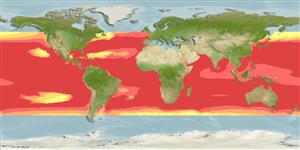Common names from other countries
分類 / Names
俗名 | 同種異名 | Catalog of Fishes(屬, 種) | ITIS | CoL | WoRMS | Cloffa
Teleostei >
Scombriformes (Mackerels)
鱸形目 (Mackerels) >
Scombridae (Mackerels, tunas, bonitos)
鯖科 (Mackerels, tunas, bonitos) > Scombrinae
Etymology: Thunnus: Greek, thynnos = tunna (Ref. 45335).
More on author: Lowe.
Environment: milieu / climate zone / depth range / distribution range
生態學
海洋; 海洋洄游的 (Ref. 51243); 深度上下限 0 - 1500 m (Ref. 117020), usually 0 - 500 m (Ref. 117020). 亞熱帶的; 13°C - 29°C (Ref. 168); 52°N - 48°S, 180°W - 180°E
Atlantic, Indian and Pacific: in tropical and subtropical waters. Absent in the Mediterranean. Highly migratory species.
大西洋,印度洋與太平洋: 在熱帶與亞熱帶的水域中。 不存在於地中海。 高度遷移的種,1982年海事法會議的附件一.(參考文獻 26139)
Length at first maturity / 大小 / 重量 / 年齡
Maturity: Lm 112.5, range 100 - 125 cm
Max length : 250 cm TL 雄魚/尚未辨別雌雄; (Ref. 27000); common length : 180 cm FL 雄魚/尚未辨別雌雄; (Ref. 168); 最大體重: 210.0 kg (Ref. 9987); 最大年齡: 11 年 (Ref. 30326)
背棘 (總數): 13 - 14; 背的軟條 (總數): 14-15; 臀棘 0; 臀鰭軟條: 14; 脊椎骨: 39. This large species is distinguished by the following characters: robust, fusiform body, slightly compressed from side to side; total gill rakers on first gill arch 23-31; dorsal fins separated only by a narrow interspace, the second followed by 8-10 finlets; anal fin followed by 7-10 finlets; pectoral fins moderately long (22 to 31% of fork length) in large specimens (over 110 cm FL), but very long (as long as in Thunnus alalunga) in smaller specimens; 2 flaps (interpelvic process) between pelvic fins; very small scales on body; corselet of larger and thicker scales developed, but not very distinct; caudal peduncle very slender, with a strong lateral keel between 2 smaller keels; ventral surface of liver striated; swimbladder present. Colour of back metallic dark blue, lower sides and belly whitish; a lateral iridescent blue band runs along sides in live specimens; first dorsal fin deep yellow, second dorsal and anal fins light yellow, finlets bright yellow edged with black (Ref. 9684).
一個大的種, 深的在第一背鰭基底的中央的附近。 下側與腹面微白色的; 一條側面的藍色虹彩的條紋在活體中沿著側邊。 第一背鰭是深黃色, 第二個背鰭與臀鰭是淡黃色的,離鰭是鮮黃色的被黑色邊緣的。
Occur in areas where water temperatures range from 13°-29°C, but the optimum is between 17° and 22°C. Variation in occurrence is closely related to seasonal and climatic changes in surface temperature and thermocline. Juveniles and small adults school at the surface in mono-species groups or mixed with other tunas, may be associated with floating objects. Adults stay in deeper waters (Ref. 5377). Eggs and larvae are pelagic (Ref. 6390). Feed on a wide variety of fishes, cephalopods and crustaceans during the day and at night (Ref. 9340). Meat is highly prized and processed into sashimi in Japan. Marketed mainly canned or frozen (Ref. 9684), but also sold fresh (Ref. 9340).
出現在區域水溫範圍從 13個 °-29 °C, 但是最適宜在 17個 ° 與 22個 ° C. 之間 出現位置的變化在水表層與躍溫層中是與季節和氣候變化有密切的關係。 稚魚與小的成魚群集在表面以單一種類的形式或者混和著其他的鮪魚了, 可能是伴隨著漂浮的目標。 成魚停留在較深的水域中。 (參考文獻 5377) 卵與仔魚是大洋性的。 (參考文獻 6390) 捕食各式各樣的魚,頭足類動物與甲殼動物在白天期間而在夜晚.(參考文獻 9340) 肉在日本被高度地珍視而且加工成生魚片。 主要地在市場上銷售將或者裝於罐頭凍結 (參考文獻 9684), 也賣了生鮮地.(參考文獻 9340)
Life cycle and mating behavior
成熟度 | 繁殖 | 產卵場 | 卵 | 孕卵數 | 仔魚
Are multiple spawners that may spawn every 1 or 2 days over several months (Ref. 30330). They spawn over periods of the full moon (Ref. 6390). Spawn throughout the year in tropical waters (Ref. 6390).大西洋,印度洋與太平洋: 在熱帶與亞熱帶的水域中。 不存在於地中海。 高度遷移的種,1982年海事法會議的附件一.(參考文獻 26139)
Collette, B.B. and C.E. Nauen, 1983. FAO Species Catalogue. Vol. 2. Scombrids of the world. An annotated and illustrated catalogue of tunas, mackerels, bonitos and related species known to date. Rome: FAO. FAO Fish. Synop. 125(2):137 p. (Ref. 168)
CITES (Ref. 128078)
Not Evaluated
人類使用
漁業: 高經濟性; 游釣魚種: 是的
工具
特別的報告
下載 XML
網路資源
Estimates based on models
Preferred temperature (Ref.
115969): 16.8 - 28.6, mean 26.6 (based on 3638 cells).
Phylogenetic diversity index (Ref.
82804): PD
50 = 0.5039 [Uniqueness, from 0.5 = low to 2.0 = high].
Bayesian length-weight: a=0.01318 (0.01039 - 0.01673), b=3.03 (2.99 - 3.07), in cm Total Length, based on LWR estimates for this species (Ref.
93245).
營養階層 (Ref.
69278): 4.5 ±0.0 se; based on diet studies.
回復力 (Ref.
120179): 中等的, 族群倍增時間最少 1.4 - 4.4年 (K=0.11-0.23; tm=3; tmax=11; Fec=2 million).
Prior r = 0.65, 95% CL = 0.43 - 0.98, Based on 5 stock assessments.
Fishing Vulnerability (Ref.
59153): High vulnerability (56 of 100).
Climate Vulnerability (Ref.
125649): Moderate to high vulnerability (47 of 100).
